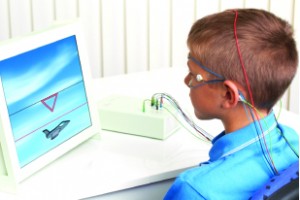By Maren Auxier
 What is neurofeedback?
What is neurofeedback?
Neurofeedback, also known as EEG biofeedback, has been studied and practiced since the late 60’s. It is exercise for your brain; allowing you to see the frequencies produced by different parts of your brain in real-time and then through visual and auditory feedback, teaches the brain to better regulate itself. Neurofeedback can be used to help detect, stimulate, and/or inhibit activity in the brain safely and without medication. It can help restore a wider “range of motion” in brain states, much like physical therapy does for the body.
While the client sits comfortably watching a movie or pictures appear on the screen (a calm and focused state), the EEG equipment measures the frequency or speed at which electrical activity moves in the areas where electrodes have been placed. This information is sent to the therapist’s computer. The therapist is then able to determine what frequencies are out of balance. For example, when the EEG shows that you are making too many “slow” or “sleepy” waves (delta/theta) or too many “fast” waves (high beta), the therapist adjusts a reward band to encourage more balanced activity. This encouragement or “reward” happens through an auditory reinforcement of “beeps” and sometimes through visual reinforcement of changes on the screen.
It is important to understand that the neurofeedback approach does not “cure” or “fix” your brain. We teach and guide your brain to produce frequencies which help it relax and/or focus. We provide the brain with gentle “challenges” and encouragement in a user-friendly, stress-free format so it learns to regulate or shift to healthier states more smoothly on its own at the appropriate time.
How does a “beep” or sound
train my brain to work better?
The auditory or sound reward that corresponds to an increase or decrease in desired brainwave activity is able to affect the brain on a neurological level. Auditory reward stimulates auditory pathways, impacts the vestibular system, and has many connections to the reticular activating system, which modulates wakefulness and attention. These systems operate in our brains without conscious effort. Therefore, neurofeedback teaches your brain through automated learning with little or no behavioral effort. Another way to say this is that neurofeedback involves operant conditioning or learning. This type of learning teaches us through a reinforced reward system. The auditory reward (beep) is delivered on a schedule of reinforcement that promotes optimal learning; not too hard and not too easy. This schedule of reinforcement or reward provides just the right amount of resistance to evoke a positive learning pattern.
Why train your brain?
Mental clarity improves when you operate a calmer, more efficient brain. As you learn to slow down “inner chatter” or activate a “sleepy” brain, you become more effective at responding to stress and adapt more readily to different situations, both psychologically and physically. Parenting becomes less exhausting, appointments are more easily kept, decision-making improves, and mood swings and depression often lift.
Neurofeedback has also been shown to be of remarkable value with school-age children who experience focus and learning problems. Through brain training, children can learn to better concentrate on schoolwork, increase their frustration tolerance level, and are less prone to be overwhelmed with sensory overload while seated in a noisy classroom. With their thoughts more organized, they can focus more clearly on what others say to them and can begin to develop friendships and learn effectively
What types of conditions
does neurofeedback help?
Symptoms of these conditions, among others, can improve through neurofeedback training:
Anxiety Sleep disorders Depression
ADD/ADHD
Sensory processing disorder
Bipolar disorder
Seizure disorders
Auditory/visual processing
Chronic pain/Fibromyalgia
Migraines/headaches
Traumatic brain injuries
Stroke
Cognitive decline
Peak performance
Oppositional defiant disorder
Rages/mood swings
Attention/focus/concentration
Reactive attachment disorder
Autism/Asperger’s
Learning disabilities
Obsessive compulsive disorder
How many sessions are needed
to begin seeing results?
As the brain learns, you will see the changes. However, everyone learns at different speeds, so it cannot be determined how quickly someone will learn. On average, children take about 10-20 sessions to see changes and we can discuss what to expect during the intake appointment. For adults changes are usually noticed within 10 sessions. Total treatment is an average of 40 sessions, however we individualize treatment – some people need more and some less.
Neurofeedback and medication
As your brain begins to work more efficiently, medications also work better. For those who cannot take or are only marginally responsive to medication, neurofeedback can offer an alternative or supportive role to drug therapy by stimulating or inhibiting brain activity at the same basic neurological level as medication. Eventually with training, many people find they are able to reduce the dosages or cease taking some prescription drugs, but only after careful consultation and planning with the prescribing physician. For this reason, neurofeedback practitioners advocate consistent communication between clients and their physicians during training and encourage discussion of their neurofeedback experience with therapists and doctors so accommodations can be made as training progresses.
WHAT IS A QEEG
(Quantitative EEG)
OR BRAIN MAP
AND DO I NEED ONE?
The QEEG is a quantitative EEG. It’s also called a brain map and does just that… it gives us a map of what is going on with the entire brain at one time. We attach electrodes to the whole head, 19 spots, and then record the brain waves with his eyes open for 5 minutes and with his eyes closed for 10 minutes. This recording is then sent to Advanced Psychological Services in North Carolina to be read and analyzed. They are able to not only give us a summary of significant findings but the report also shows the results of analyzing the data several different ways. The brain activity is not only compared spot by spot over the entire head, but we can also look at connections, symmetry, how different parts are communicating and all of this data is compared to a database of peers (same sex, handedness and age). It can help us see what areas need to be addressed more efficiently than just training spot by spot.
We don’t always need this data to make improvements in symptoms but we do recommend it in certain situations. A QEEG can also be helpful information when diagnosing and/or trying to decide the best medication/supplement recommendations.
HOW DO I GET STARTED?
Getting started with Neurofeedback is fairly simple. Call, text, or email our office to set up an intake session. At the intake session, you will receive a clinical interview, treatment plan recommendations, and a Neurofeedback session (if warranted in your treatment plan). We will also discuss the necessity or timing of a brain map or QEEG. It is not recommended that you stop your medication and you can continue your therapies. Call to make an appointment today!
Renee Chillcott, LMHC
Renee Chillcott is a Licensed Mental Health Counselor that has been practicing Neurofeedback training since 2005. Renee attended The University of Central Florida where she received her Bachelor of Arts Degree in Psychology in 1995. She then went on to complete her Master’s Degree in Mental Health Counseling with Nova Southeastern University in 2001. She has been a mental counselor in a variety of settings including Outpatient Treatment Agencies, Alternative Education Settings, and Private Practice. Renee received her license in Mental Health Counseling in 2004. Renee decided to enter the field of Neurofeedback because there was very little information made available to people/parents about alternatives to medication. Through the use of Neurofeedback she saw more significant and permanent changes in not only her clients, but also her own family and herself. This inspired her to become the owner/operator of The Wellness Center, located in Boca Raton. At The Wellness Center, adults, teens, children and families enjoy a variety of services from multiple providers. Neurofeedback, Brain Mapping, Acupuncture, Nutritional Counseling, Learning Programs, and counseling are among a few of the services offered.
Brain & Wellness Center
Check Also
Breaking Through the Pain: How the Stealth Laser is Revolutionizing Nerve Pain Treatment
Nerve pain, or neuropathic pain, is one of the most challenging conditions to treat in …
 South Florida Health and Wellness Magazine Health and Wellness Articles
South Florida Health and Wellness Magazine Health and Wellness Articles




